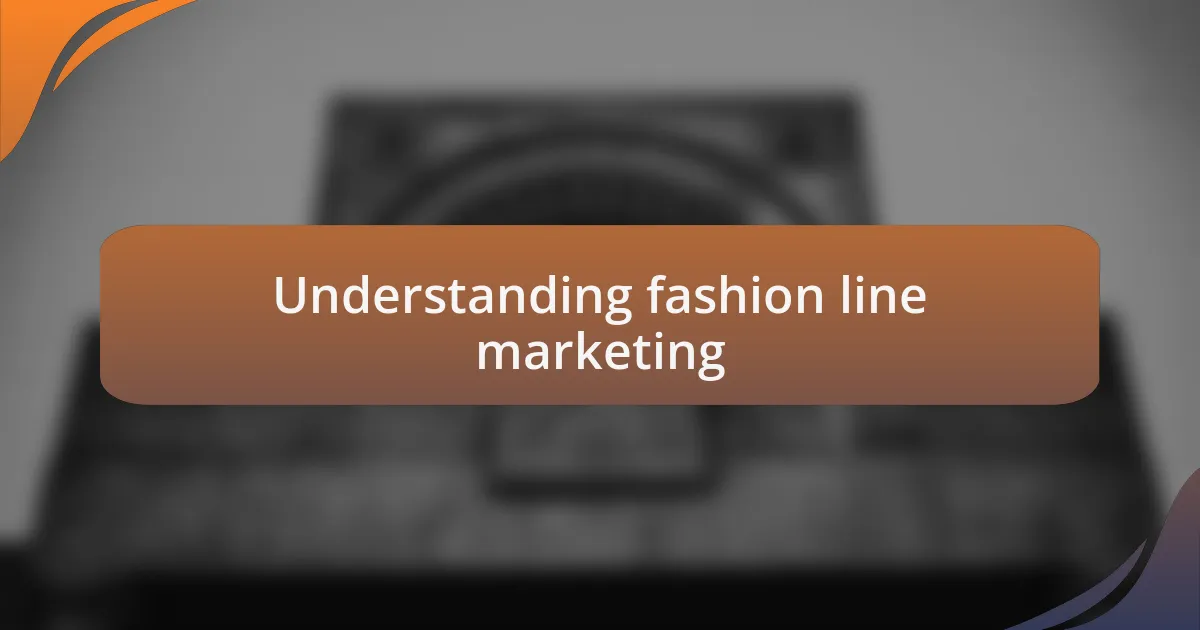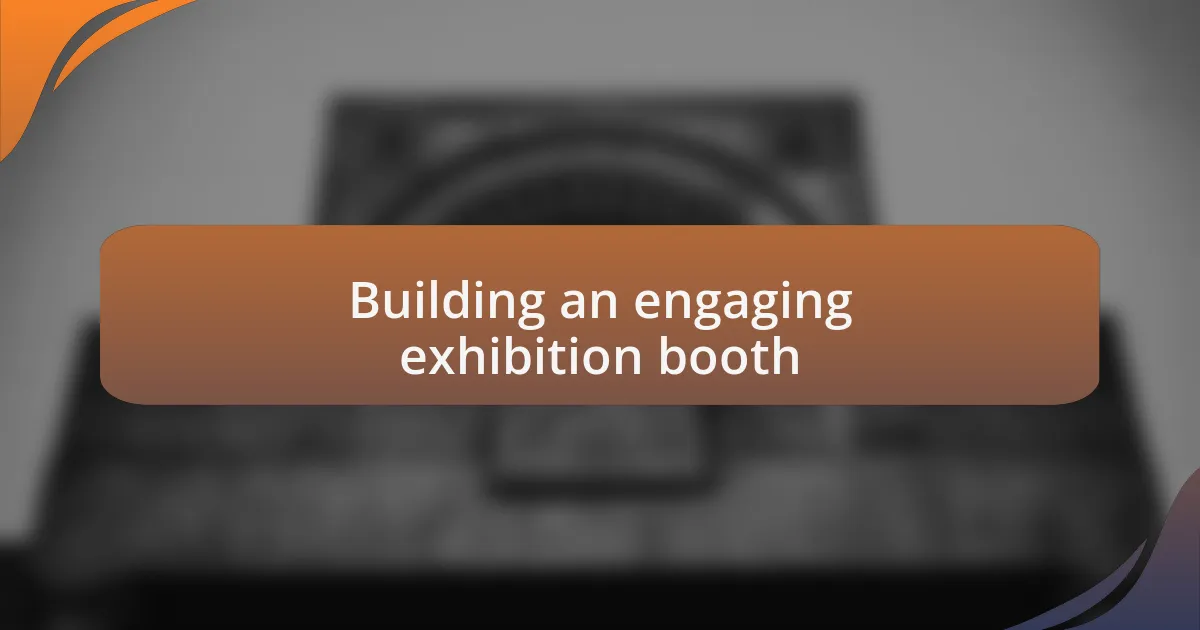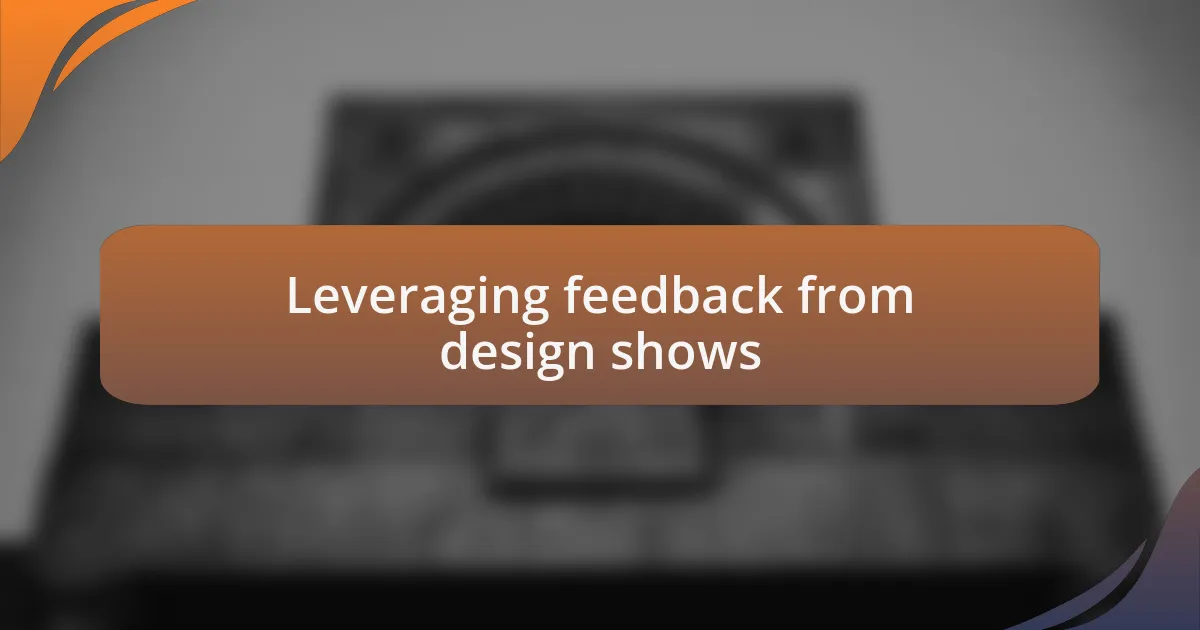Key takeaways:
- Success in fashion marketing depends on emotional connection with customers and understanding their preferences.
- Design exhibitions provide valuable networking opportunities and real-time audience feedback that can refine design strategies.
- Effective marketing strategies for exhibitions include interactive displays, social media engagement, and collaborations with influencers.
- Creating an engaging booth with thoughtful layout, visual storytelling, and appropriate lighting enhances visitor experience and connection to the brand.

Understanding fashion line marketing
Marketing a fashion line is about more than just selling clothes; it’s about telling a story that resonates with your audience. I remember when I first started out, I faced the challenge of conveying my unique style and vision. That experience taught me that connecting emotionally with customers is key. If they feel a part of your journey, they’re more likely to become loyal supporters of your brand.
Additionally, understanding your target demographic is crucial. I vividly recall diving deep into market research to understand my ideal customers’ preferences, ages, and lifestyles. It was fascinating to discover what truly makes them tick. What do they value in fashion? Answering that question helped shape how I presented my pieces, ensuring each collection spoke directly to their desires.
I also learned that social media is a powerful tool for fashion marketing. As I honed my skills in creating engaging content, I saw firsthand how Instagram stories could bring my designs to life—showing not just the clothes, but the lifestyle they represent. Have you considered how your designs fit into the lives of your customers? This perspective can transform how you communicate your brand and create a more inclusive community around your fashion line.

Importance of design exhibitions
Attending design exhibitions is crucial for understanding the pulse of the fashion industry. I still remember my first exhibition; I walked in, surrounded by creativity and innovation, and realized how invaluable it is to see what others are doing. It inspires me to think outside the box and rethink my own designs. Have you ever felt that spark of creativity just by being in a vibrant space filled with artistic expression?
These events also create networking opportunities that can lead to collaborations and partnerships. While at one exhibition, I met a textile designer whose work perfectly complemented my collection. That chance encounter not only expanded my creative horizons but also opened doors to new business opportunities. Isn’t it remarkable how one conversation can change your trajectory?
Moreover, design exhibitions allow brands to gauge audience reactions firsthand. I often take notes while observing how people interact with my designs; their responses provide insight into what resonates and what doesn’t. It’s a real-time feedback loop that’s hard to achieve elsewhere. Have you thought about how direct audience interaction could refine your design strategy? Such experiences are invaluable for any designer eager to evolve and connect with their market.

Marketing strategies for exhibitions
Marketing strategies for exhibitions must be both creative and strategic to truly stand out. One effective approach I’ve employed is to create interactive displays that not only showcase my designs but invite participation. I remember incorporating a live demonstration of my design process at one exhibition, which captivated the audience and allowed them to engage with my brand on a personal level. Have you considered how involving your audience can deepen their connection to your work?
Another crucial strategy is effective use of social media before, during, and after the event. I often share behind-the-scenes content leading up to the exhibition to build anticipation. This year, I posted sneak peeks of my latest collection on Instagram, and the excitement around my booth was palpable. Are you utilizing your online presence to create buzz around your exhibition appearances?
Finally, partnerships with influencers or fellow designers can amplify your reach significantly. During one exhibition, I collaborated with a well-known fashion influencer who wore my designs, leading to incredible foot traffic at my booth. The ripple effect of that partnership was astounding, as new audiences discovered my work through someone they trusted. Have you thought about how collaboration could elevate your visibility during exhibitions?

Building an engaging exhibition booth
When I think about creating an engaging exhibition booth, the layout plays a vital role in drawing people in. One time, I designed my space with a cozy lounge area where visitors could relax, instantly making my booth feel more inviting and accessible. Have you noticed how a comfortable environment can transform the visitor experience?
Another aspect that stands out is the importance of visual storytelling through displays. During a recent exhibition, I showcased my collection using a bold backdrop that reflected the essence of my designs. I found that when I paired each piece with a compelling story, visitors felt more connected to the garments. Isn’t it fascinating how well-crafted narratives can make your work resonate more deeply?
Lighting also cannot be overlooked; it’s one of the most powerful tools I’ve encountered in setting the mood of a booth. At one exhibition, I used soft, warm lights to highlight my pieces, creating a welcoming atmosphere that drew in curious onlookers. It’s interesting to think about how a simple adjustment in lighting can alter the way attendees perceive your work, don’t you agree?

Networking during design exhibitions
While attending design exhibitions, I quickly realized that networking is the lifeblood of building valuable connections. At one event, I struck up a conversation with a fellow designer while we were waiting for our turn at the coffee station. This casual chat turned into a collaboration opportunity that fundamentally changed my approach to marketing. Have you ever experienced how a simple moment can snowball into something much bigger?
I’ve also discovered that being open and approachable is key. During a particularly busy exhibition, I made it a point to ask visitors about their interests and opinions on my designs. Each conversation felt enriching, revealing insights that not only improved my collection but also fostered genuine relationships. Have you ever considered how those small interactions can open doors to future projects or partnerships?
In my experience, follow-up is crucial after making initial connections. After one exhibition, I sent personalized emails to contacts I met, thanking them for their time and sharing ideas on how we might collaborate. This thoughtful gesture often led to deeper discussions and sometimes even friendships. Isn’t it amazing how a little effort in following up can take a fleeting exchange and turn it into a lasting relationship?

Leveraging feedback from design shows
After a design show, I often find myself reflecting on the feedback I’ve received. One year, I showcased a new collection, and several attendees pointed out that one color palette wasn’t resonating as well as I had hoped. Initially, it stung a bit, but I took that feedback and revised the palette, ultimately creating a version that was much more popular. Have you ever had someone’s honest opinion lead to a breakthrough for you?
Embracing feedback has made a profound difference in my design journey. At another exhibition, I had a mentor approach me with critiques on the fit of my garments. Rather than feeling defensive, I listened intently and even took notes. That advice influenced my next line significantly, resulting in better reviews and increased sales. Isn’t it fascinating how constructive criticism can propel our work forward?
I’ve learned to actively seek out opinions, too. After showcasing at a recent event, I gathered informal surveys from attendees about their thoughts on my collection. The results were eye-opening and guided my marketing strategy for the following season. How often do we overlook the value of our audience’s insights, only to discover that they hold the key to our success?